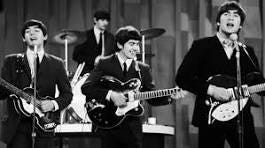If we were to identify the landmark musical moments of the early 1960s, few would disagree that the Beatles’ television debut on the Ed Sullivan Show in February 1964 and Bob Dylan’s decision to perform an electric set at the Newport Folk Festival in July 1965 would be hot contenders for inclusion.
When I asked TERRI THAL, Dylan’s first manager at the very start of the decade, to speculate on the relationship between the Fab Four’s sensational baptism and the US folk scene at the time, she responded with her usual eloquence, echoing the insight and authority she brought to her autobiography My Greenwich Village: Dave, Bob and Me in 2023.
In the third and final dispatch from Thal for R&BG, the woman who was friend and mentor to Dylan, wife of legendary singer Dave Van Ronk and one of the most active promoters of the Village folk community, shares her reflections on the impact the group from Liverpool had on the local New York scene.
While she had a vested concern with the survival of the acoustic tradition, she also had a personal interest in the band who not only led the British Invasion but also, in part, gave birth to a new Dylan, a Dylan no longer tethered by the historical restraints of folk’s pure past and keen to unleash the amplified sounds ringing in his creative mind…
____________________________________________________________________________
‘Folkies and the Beatles’
By Terri Thal
LIKE MILLIONS of Americans, Dave and I were riveted to our TV the night the Beatles appeared on the Ed Sullivan Show. And we were knocked out. Thought they were great. I’m not a musician and couldn’t have said how what they were doing differed from the pop music I’d heard…but it did and I knew it, and so did most of the folk music world.
When I talk about the ‘folk music world’, I’m talking about the folk musicians who gathered in street scenes and coffee houses and liquor clubs and record stores and Alan Block’s sandal shop and my living room and other people’s apartments and the Folklore Center and school auditoriums to make music.
They played acoustic guitar and steel guitar and banjo and fiddle and mandolin and harmonica and bass/cello and kazoo and autoharp and tambourine and ukulele and dulcimer and washtub bass and piano. They could play spoons and washtubs and washboards and jugs. They played ballads and work songs and sea shanties and blues and spirituals.
The three-volume American Folk Music set of LPs, selected and organized by Harry Smith and issued by Folkways Records in 1952, had 167 songs on it…and in the 1950s and into 1960 or 1961, they comprised the basic repertoire of the New York City folk singers.
But even before the Beatles showed up, those folk musicians started to change the music. Peter Stampfel and Steve Weber – who became the Holy Modal Rounders –turned country music into psychedelic music, keeping the words and basic music of the songs they adapted.
Tom Paxton came to town and played only songs that he’d written…and they sounded just like folk songs. The poet Bob Kaufman and Len Chandler adapted a children’s song into 'Green, Green Rocky Road’ and Dave Van Ronk sang and recorded it. Bob Dylan and Phil Ochs wrote new songs about racism in America, and no one complained.
A group of young musicians created the Even Dozen Jug Band, which spawned the Jim Kweskin Jug Band in Cambridge, and Dave Van Ronk and the Ragtime Jug Stompers. We all listened avidly to blues bands that played electric instruments: Muddy Waters, Howlin’ Wolf, Paul Butterfield. And to Indian ragas; Ravi Shankar was recording in the U.S. in 1958, and folkies were listening to him – mostly without understanding the music, I think – by the early Sixties.
So we were ready for a new sound and, by 1964, a group that created intelligent and intelligible arrangements, sang songs that were reasonably grown-up but not blatantly sexual or about romance, didn’t blast so loudly they hurt our ears, struck us as fresh and interesting and exciting.
©Terri Thal 3/2025
See also: ‘Terri Thal #2: That Dylan movie’, May 6th, 2025; ‘Terri Thal #1: The Beats and me’, April 14thAll that, 2025



